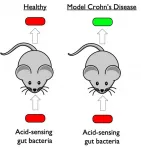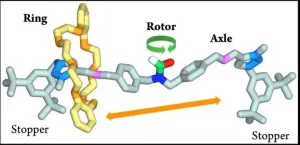(Press-News.org) Rivaroxaban, in addition to low-dose aspirin, significantly reduced the occurrence of total severe events of the heart, limb or brain and issues related to other vascular complications in patients with symptomatic peripheral artery disease (PAD) who underwent lower extremity revascularization, a procedure to open blocked arteries in the leg. The findings, presented at the American College of Cardiology's 70th Annual Scientific Session, expand on earlier data and underscore the broad absolute benefits of this strategy in this high-risk patient population, researchers said.
"To our knowledge, this is the first time that the addition of low-dose rivaroxaban to aspirin has been clearly shown to reduce the occurrence of both first and total adverse events in patients with PAD who have undergone lower extremity revascularization but remain at high risk for a heart attack, stroke or recurrent arterial blockage in a limb," said Rupert Bauersachs, MD, director of vascular medicine at the Darmstadt Clinic in Germany and lead author of the study. "The benefits we saw in the trial for first events were statistically significant and entirely consistent with those for total events. Rivaroxaban 2.5 mg twice daily with aspirin should be considered as adjunctive therapy after revascularization to reduce first and subsequent adverse outcomes."
An estimated 10 million U.S. adults and 200 million people worldwide have PAD, which is often associated with leg pain, difficulty walking and poor circulation that can lead to non-healing wounds and a high rate of limb loss. People with PAD are at very high risk for serious complications, including acute limb ischemia--similar to a heart attack or stroke of the leg--that can lead to limb amputation or death if not treated quickly. Patients with symptomatic PAD are commonly treated with procedures to open arteries in the leg to improve symptoms and prevent limb loss, but they remain at very high risk for adverse events. Overall, about 1 in 4 patients with symptomatic PAD require a repeat procedure to open a blocked leg artery.
"There is a need for greater awareness that PAD is a distinct disease state and that patients with PAD have a high risk for cardiovascular adverse events and are generally a very vulnerable population, especially in the post-revascularization setting," Bauersachs said. "Care for these patients is often fragmented because the surgeon who performs the revascularization may not follow them for complications or recurrences. They deserve to receive optimal treatment to reduce the risk of recurrences."
The randomized, double blind, international trial, known as VOYAGER PAD, enrolled 6,564 patients in 34 countries who had PAD and had undergone lower extremity revascularization. The patients' median age was 67 years and 74% were men. Patients were randomly assigned to receive rivaroxaban or a placebo in addition to daily aspirin. The trial was double blinded, meaning that neither the patients nor their doctors knew who was receiving rivaroxaban and who was receiving the placebo. The trial's primary endpoint was timed to the first event of a composite of acute arterial blockage in the leg (called acute limb ischemia), leg amputation due to blood-vessel disease, heart attack, stroke or death due to cardiovascular causes. Another prespecified endpoint was the total number of vascular events, including recurrent primary endpoint events as well as other vascular events like blood clots in the leg veins or lungs or the need for repeat vascular procedures. The median follow-up time was 28 months after patients underwent revascularization.
The research team reported in a late-breaking clinical trial presented at ACC.20/WCC that the trial met its primary endpoint, with a 15% statistically significant reduction in the risk of a first major adverse limb or cardiovascular event seen in patients who received rivaroxaban compared with those who received the placebo. The current study reports on the total number of vascular events with over 4,700 occurring in the 6,564 randomized over three years.
"There were 342 fewer adverse events in the rivaroxaban group than in the placebo group, which translates to an absolute reduction in risk of 12.5%," Bauersachs said. "In a high-risk population, that is a big gain in avoiding the need for patients to come back with vascular complications."
The 6,564 study participants experienced a total of 4,714 vascular events during the study period with 2,301--or about one-third--experiencing at least one vascular event, Bauersachs said.
"So, during approximately three years of follow-up, about 2-3 out of 6 patients with PAD had a vascular event in spite of high utilization of background medical therapy. This overall rate of vascular events is eye-opening and speaks to the high vulnerability of this patient population," Bauersachs said. "First events are just the tip of the iceberg."
A limitation of the study is that the trial was designed to assess the occurrence of first adverse events following lower extremity revascularization, Bauersachs said. Therefore, in a double blinded trial, patients may come off study treatment or go on to other therapies after an event, which can attenuate the observed benefit. Assessment of the total number of adverse events, however, was a prespecified secondary endpoint and despite this limitation, the findings were statistically significant and robust in absolute terms.
INFORMATION:
This study was simultaneously published online in the Journal of the American College of Cardiology at the time of presentation. The study was funded by pharmaceutical companies Bayer and Janssen.
Bauersachs will be available to the media in a virtual press conference on Sunday, May 16, at 9:45 a.m. ET / 13:45 UTC.
Bauersachs will present the study, "Reductions In Total Ischemic Events With Rivaroxaban In Patients With Symptomatic Pad After Revascularization: The VOYAGER PAD Trial" on Sunday, May 16, at 8 a.m. ET / 12:00 UTC.
ACC.21 will take place May 15-17 virtually, bringing together cardiologists and cardiovascular specialists from around the world to share the newest discoveries in treatment and prevention. Follow @ACCinTouch, @ACCMediaCenter and #ACC21 for the latest news from the meeting.
The American College of Cardiology envisions a world where innovation and knowledge optimize cardiovascular care and outcomes. As the professional home for the entire cardiovascular care team, the mission of the College and its 54,000 members is to transform cardiovascular care and to improve heart health. The ACC bestows credentials upon cardiovascular professionals who meet stringent qualifications and leads in the formation of health policy, standards and guidelines. The College also provides professional medical education, disseminates cardiovascular research through its world-renowned JACC Journals, operates national registries to measure and improve care, and offers cardiovascular accreditation to hospitals and institutions. For more, visit ACC.org.
Media Contacts
Nicole Napoli
202-669-1465
nnapoli@acc.org
Thy-Ann Nguyen
703-479-3642
thyann.nguyen@curastrategies.com
In patients who had a coronary stent inserted after experiencing the most severe type of heart attack, the use of a technique that measures blood flow and pressure through a partially blocked artery to determine if a second stenting procedure is needed did not improve outcomes and was more costly than using angiography, or a heart X-ray, alone to guide the procedure, according to research presented at the American College of Cardiology's 70th Annual Scientific Session.
"The strategy of using fractional flow reserve (FFR) to guide the stenting procedure is not superior to the standard technique of using angiography to treat additional partially blocked arteries," said Etienne Puymirat, MD, professor of cardiology at the University of Paris, director of intensive care at the Georges ...
HOUSTON - (May 17, 2021) - In an important step toward the clinical application of synthetic biology, Rice University researchers have engineered a bacterium with the necessary capabilities for diagnosing a human disease.
The engineered strain of the gut bacteria E. coli senses pH and glows when it encounters acidosis, an acidic condition that often occurs during flareups of inflammatory bowel diseases like colitis, ileitis and Crohn's disease.
Researchers at the University of Colorado (CU) School of Medicine used the Rice-created organism in a mouse model of Crohn's disease to show acidosis activates a signature set of genes. The corresponding ...
Humans leave their "footprints" on the land area all around the globe. These land-use changes play an important role for nutrition, climate, and biodiversity. Scientists at the Karlsruhe Institute of Technology (KIT) combined satellite data with statistics from the past 60 years and found that global land-use changes affect about 32 percent of the land area. This means that they are about four times as extensive as previously estimated. The researchers publish their findings in the scientific journal Nature Communications.
Whether it is deforestation, urban growth, agricultural expansion, or reforestation - land-use changes are diverse and have ...
Researchers from Tohoku University have developed a new numerical method that paves the way for simulating landslide tsunamis.
Their research was published in the journal Computational Mechanics on May 13, 2021.
Landslides occurring on land or underneath the sea - known as subaerial and submarine landslides respectively - can cause devastating tsunamis. They also pose other hazards such as severing submarine cables and pipelines.
Yet the mechanisms at play behind these landslides are less well understood, partly due to the multifaceted interactions taking place: a collapse of the seabed and/or the interaction between soil and water. Conventional approaches make it difficult to ...
Clinics that mailed mifepristone and misoprostol tablets to patients during the pandemic have experienced a high demand and have been able to safely screen and care for patients via telehealth, according to two studies recently published online in the journal Contraception.
The first study identifies factors that supported the provision of abortion pills across four healthcare settings. Factors that contributed to success included clinic staff helping to organize the telehealth appointment and to distribute pills, the first paper noted, as well as already having telehealth ...
Doctors often recommend Omega-3s to help patients lower their cholesterol and improve heart health. Those Omega-3s can come from fatty fish like salmon and mackerel, or supplements that often contain a combination of the acids eicosapentaenoic acid (EPA) and docosahexaenoic acid (DHA).
Now, new research from the Intermountain Healthcare Heart Institute in Salt Lake City finds that higher EPA blood levels alone lowered the risk of major cardiac events and death in patients, while DHA blunted the cardiovascular benefits of EPA. Higher DHA levels at any level of EPA, worsened health outcomes.
Results of the Intermountain study, which examined nearly 1,000 patients over a 10-year-period, will be presented virtually at the ...
Gears and mechanical transmissions are at home in the Emilia-Romagna region, the Motor Valley of northern Italy. A team of researchers from the University of Bologna and the Institute for Organic Synthesis and Photoreactivity of the National Research Council (Cnr-Isof) in Bologna, led by Massimo Baroncini and Alberto Credi, has planned, constructed and operated NanoGear, a device consisting of interlocked molecular components and designed to function as a gear. Since molecules are nanometric objects (1 nanometer = 1 millionth of a millimetre), it is an exceedingly small device: certainly, ...
DALLAS, May 17, 2021 -- Detecting a critical heart defect before birth (congenital heart defects) is less likely when a mother lives in a rural area, lives in a neighborhood with low socioeconomic status or is Hispanic, according to new research published today in the American Heart Association's flagship journal Circulation.
Diagnosing a heart defect before birth reduces infant death rates, increases access to prompt medical treatment, improves neurodevelopmental outcomes and decreases the risk of brain injury for the infant after birth.
"The benefits of prenatal diagnosis for heart defects have been recognized for years, yet prenatal detection occurs in less than 60% of congenital heart disease cases in many U.S. ...
A valve invented by engineer Nikola Tesla a century ago is not only more functional than previously realized, but also has other potential applications today, a team of researchers has found after conducting a series of experiments on replications of the early 20th-century design.
Its findings, reported in the journal Nature Communications, suggest that Tesla's device, which he called a "valvular conduit," could harness the vibrations in engines and other machinery to pump fuel, coolants, lubricants, and other gases and liquids.
Now known as the Tesla Valve, the patented device has inspired strategies for ...
A study published in the scientific journal Addiction provides the most comprehensive evidence to date of the association between recreational cannabis laws (RCLs) in US states and responses in the illegal markets for cannabis, heroin, and other drugs in those states.
As of 2021, 17 US states and the District of Columbia have implemented RCLs that allow people aged 21 and older to possess, use and supply limited amounts of cannabis for recreational purposes. This study found that the implementation of RCLs was associated with the following responses in the illegal drug market in those states:
9.2% decrease in street/illegal cannabis ...




